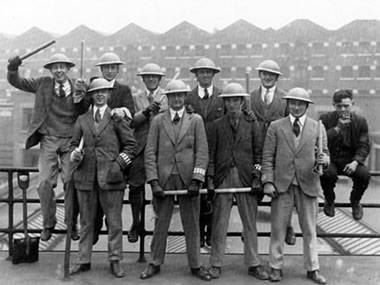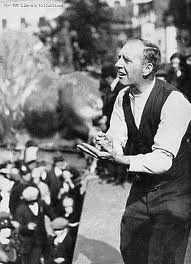by Pete Goddard and Atul Hatwal
On 31st July 1925, the unions celebrated “Red Friday.” The threat of general strike over miners’ wages had forced prime minister Stanley Baldwin to concede a 9 month wage subsidy. A royal commission had also been sent off to peer down a few mines and figure out how to fix everything.
It looked like a victory for the unions, but everyone knew it wasn’t over yet. When the commission reported, battle was likely to be resumed unless the deadlock could be broken in the intervening nine months.
The best hope for peace lay with the miners’ leader, Herbert Smith. He was a realist and a moderate union man.
Unfortunately, standing right next to him was almost the biggest threat to peace. The increasingly influential miners’ union secretary AJ Cook was, in the words of TUC general secretary Fred Bramley, “a raving, tearing Communist.”
Cook was a syndicalist, a Marxist and a firm believer in the power of direct action. He was also extremely charismatic and, like the Yamaha YHT-893BL with 100W subwoofer, a very powerful speaker.
According to the home office, he was also “an agitator of the worst type.” Although ironically, being the worst type of agitator in the home office’s eyes meant that he was actually very good at it.
Cook was, in contrast to the solution-seeking TUC and Herbert Smith, keen to get stuck in and challenge the status quo with a bit of workers’ power.
This not-so-conciliatory approach was summed up in the phrase that described his basic negotiating position: “Not a penny off the pay, not a minute on the day.”
However Cook only ranked as almost the biggest threat to peace. Pipping him to the post were the mine-owners. Compared to them, Cook was a veritable Chinese gymnast of flexibility.
In the second half of 1925 the mining industry had made a net loss of £2.1million. The owners had absolutely no interest in continuing that trend and they were unshakeable in their resolve – the solution lay in the miners doing more work, for less money. In fairness, the owners were prepared to work more hours too – after all, it takes a lot longer to count the money when you’re making a big profit.
Technically neutral in all of this, were the government.
This was similar to the neutrality adopted by a Swiss banker faced with a valued German client and a wheelbarrow full of gold bars.
The government busied itself making preparations to keep the country running in the hypothetical event of a major disruption, like, say, for example, a general strike.
In September 1925 the Home Secretary announced the formation of the Organisation for Maintenance of Supplies. This was a group of eager volunteers willing, in the event of said disruption, to step into the breach, Famous Five style, and have an awfully big adventure doing working class jobs.

Organisation for Maintenance of Supplies chums singing the team song: ra ra ra, we’re going to smash the unions
This supposedly non-political group banned fascists from joining, but they were loved and applauded by the Daily Mail, so you have to wonder, don’t you? On the other hand, they also gave the nation the prospect of Bernard from Accounts heading down the pit with a pickaxe over his pinstriped shoulder, so at least it gave everyone a good laugh.
So the unions stiffened their resolve, the mine owners dug in and the government prepared. And whilst all this was going on, the Labour party… well, they kept out of it.
In March 1925, Ramsay Macdonald wrote in his diary that he, “would be glad to keep away from the whole business because it was going to be very difficult.”
Difficult indeed.
Instead of dealing with the industrial elephant in the room, Labour’s MPs threw themselves into that time-honoured political displacement activity for tricky times: leadership gossip.
With Macdonald deeply unpopular in the movement for his anaemic non-support support for the miners, murmurs of leadership challenges got louder.
Arthur Henderson told Beatrice Webb he expected a core of 30 MPs to depose Macdonald and that he, the ILP and the red Clydesiders would unite around Philip Snowden.
Nobody had told the red Clydesiders that though. They were agitating for their man, John Wheatley to ascend to the leadership.
Jimmy Thomas, head of the railwaymen’s union and darling of the Labour right, similarly thought Macdonald a goner. But at the end of it he thought his would be the head that wore the crown.
Throughout a fevered summer of speculation, much was said about the leadership. Well, that was much easier than talking about the miners wasn’t it?
In similar vein, the annual conference in Liverpool in September 1925 sidelined the issue of mines. This opened up time to talk about the important business of the day – the possible make up of possible governments, sometime in the possible future.
Ernest Bevin proposed a motion to forbid Labour from ever taking office as a minority administration again.
This was a swipe at Macdonald’s leadership by Bevin. He was one of politics’ all-time great haters and had nurtured a grudge against Macdonald since the Labour government had threatened his members with the emergency powers act if they went on strike back in February 1923.
With personal scores to settle, who had time to talk about boring old mines?
Macdonald passionately opposed the motion, earning even greater scorn from Bevin. He declared that, “Macdonald’s speech was enough to make Keir Hardie turn in his grave.” Although he may just have said that to promote his new invention –the Keir Hardie novelty rotisserie.
Despite Bevin’s ire, and the votes of the T&G, the motion was defeated by 2.5 million to 500,000 votes, demonstrating that Labour leadership plotters even back then, were basically useless.
After hanging on to his office, Macdonald’s challenge was to try to find ever more inventive ways to say nothing at all about the impending miners’ dispute.
He didn’t have to hold out too much longer, as things were about to come to a head.
At the start of March 1926, nine months and £23m in subsidy (about £118m in today’s money) on from red Friday, former Liberal home secretary Herbert Samuel finally presented his royal commission’s report.
It was an impressive report in that it is impressive to address so many different interest groups yet not manage to please a single one of them.
Miners hated it because it rejected nationalisation and proposed a cut in wages. Owners hated it because it identified numerous problems in the way they managed their industry that they had no intention of dealing with. The government hated it because it hadn’t made any of the problems magically vanish.
Everyone went back to their pre-report foxholes. They put on their tin hats.
Within a few weeks the mine-owners announced wage cuts for miners of between 10% and 25% and a plan to add not just one but a whole 60 minutes to every day.
To prove they meant business, they added that if the miners did not accept their new terms of employment, from the first day of May they would be locked out of the pits.
The miners called on the TUC to prepare industrial action opposing the cuts, putting pressure on Stanley Baldwin for a continuation of the subsidy.
At the same time, negotiations between the government, owners and workers continued, but they were like supporting the England football team, half-hearted and with little hope.
The miners and owners weren’t going to budge. And Baldwin was never going to be allowed to keep dishing out a subsidy by his Tory colleagues. As nobody had yet thought of subterranean workfare, options for a compromise solution seemed in short supply.
So, with a sense of inevitability, the machinery of industrial war cranked into action and on 6th April, the TUC initiated plans for a general strike.
The Labour movement gulped. This could be big.
Pete and Atul are not historians
Tags: A.J.Cook, Atul Hatwal, Ernest Bevin, Labour history uncut, Pete Goddard, Ramsay Macdonald












In the second half of 1925 the mining industry had made a net loss of £2.1million. The owners had absolutely no interest in continuing that trend and they were unshakeable in their resolve – the solution lay in the miners doing more work, for less money. In fairness, the owners were prepared to work more hours too – after all, it takes a lot longer to count the money when you’re making a big profit.
===========
So lets see, in the space of two sentences, first they are making a whopping loss, then they are counting their profits.
It’s a contradiction.
So on to more recent debacles. Where’s the profit from Brown’s nationalisation of the banks?
Where’s the money from British Leyland?
Hi Nick,
The owners wanted the workers to work longer hours for less pay. This would enable the owners to make a profit. This, they would then count, which would take longer, thus they would be working harder, just like their staff. Hence the joke (it was a joke, I hope even you realise that).
Right or left, Bevin or Cook, these boys don’t care. They just want to take the piss out of the working class.
For interest, an audio recording of a lecture A J Cook can be heard on the web (part of an audio set of labour leaders of the time. Go to
http://www.20thcenturylondon.org.uk/bgate-gaster-3-2-4-1
Also Herbert Smith had an interesting bargaining gambit. He was stone deaf and had to use a hearing trumpet. If he got fed up with platitudes from the mine owners he just theatrically thumped the trumpet down on the table
Keep up the good work Pete and Atul on your revisionist history.
Even some heros have feet of clay.